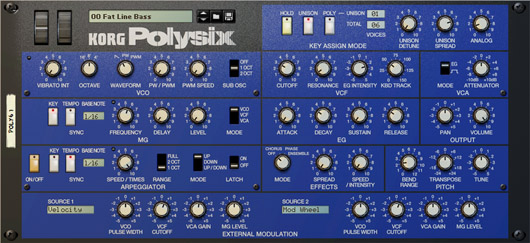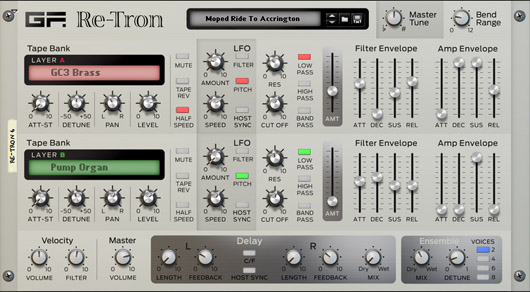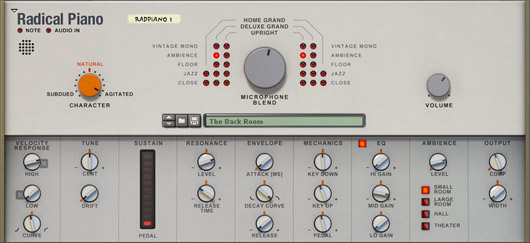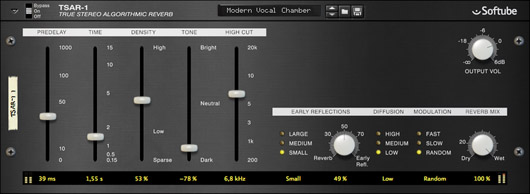Review: Rack Extensions for Reason
Propellerhead‘s Reason software can be a divisive topic amongst producers; some swear by it as […]

Propellerhead‘s Reason software can be a divisive topic amongst producers; some swear by it as their be-all and end-all production DAW, while others refuse to liken it to anything other than a toy. Detractors of the software have long pointed to the fact that third-party plug-ins (VSTs, Audio Units, and the likes) could not be used inside the program, arguing that this made for a less-professional product. Now, Propellerhead has attempted to meet those calls halfway with the introduction of Rack Extensions—offering a host of third-party synths, effects, and more developed specifically for Reason.
From the onset, there are a few really smart things that Propellerhead has implemented here. First of all, as these plug-ins were developed specifically for Reason, their implementation into the program is virtually seamless. The devices (once downloaded and installed—an incredibly painless process in its own right) are instantly usable and act just like any other unit in Reason, even including the wiggly patch cables in the back of the rack. Secondly, each Rack Extension a user purchases can be downloaded an infinite amount of times through one’s Propellerhead account, to be used on their registered copy of the software. This means that even if your computer crashes and loses all of its data, you’ll still be able to re-download all of the extras that you purchased (along with the program). And, perhaps best of all, each Rack Extension is available as a fully functional 30-day demo, giving you ample time to assess whether or not you’re ready to drop between $15 and $149 on a specific audio tool.
Given that there are already 27 of these bits of software available (with more likely on the way), we thought we’d pick out a few of the highlights and disappointments of the bunch, in order to give a better idea of what’s being offered.
Re-Tron by GForce; $75
This synth claims to take inspiration from the legendary Mellotron keyboard (a ’60s instrument that utilized polyphonic tape relays to play back sound, essentially a precursor sampling keyboards), and while it does bear some resemblance with that machine’s warbly, ghostly tones, this device is really more like a Mellotron on steroids. This hybrid results in a really interesting array of sounds that are easily tweakable, and out of all the sound generators offered as Rack Extensions, the Re-Tron is one of the most unique out of the box.

Radical Piano by Propellerhead; $99
Although most would rightly argue it’s damn near impossible to get a fake piano to sound like a real one, Radical Piano does an admirable job. Sure, you’re not going to trick anyone into thinking you went to a professional studio and sat at a Steinway, but with a good amount of knob turning and effects editing, you can get a pretty realistic tone, or—better yet—a really unique, quasi-piano sound. Best yet, this plug-in has an external input option as well, allowing you to run any signal you want through its crystal-clear signal path.

Resampler by Blamsoft; $15
The Resampler is a one-trick pony with bitcrushing on its mind. The amount of knobs it takes to get this done (admittedly just three) is maybe a little bit of overkill, but it doesn’t take much to make this guy sound great. Although, anything more than $15 would be asking a bit much for this feature.

Polysix by Korg; $49 (pictured at top)
Whether or not this plug-in is a faithful reproduction of Korg’s classic Polysix synth is something for nerds of greater esteem to debate. For the user not necessarily concerned with recreating a “true” vintage sound, this Rack Extension is just not very rewarding or fun to use. The presets get you started in decent spots, but at times, certain parameters seem unresponsive and don’t yield the results they did on a previous patch. More likely than not, this one just takes more time to get the hang of, but we’re talking about a $49 plug-in here—you quickly start to wonder if it’s really worth the effort.
TSAR-1 Reverb by Softube; $149
Currently the most expensive Rack Extension available, the TSAR-1 Reverb does offer an impressive array of options with useful points of customization and a rich, natural sound quality. Furthermore, its interface is simple, clean, and just plain easy to use, making it possible to land on a distinct tone in no time. For those on a budget, there’s also a $49 version available with fewer customizable parameters.

AF-4 Analog by Synapse Audio; $49
Another simple unit that packs a lot of power, the AF-4’s best feature is its “Drive” knob, which adds a tasteful warmth to most signals. The only drawback to this device is that there is no option to change the filter type to high-pass or band-pass, it is permanently only a low-pass filter. However, there is a side-chain input option, which helps make up for that fact.

ABL2 Bass Synth by Audio Realism; $59
Making a digital emulation of the legendary 303 has never been an easy feat, and the ABL2 is yet another attempt that falls short of capturing those distinct tones in plug-in form. The “Drive” and “Distort” knobs—along with a considerably responsive filter section—do help a lot in this effort, and certain combinations can yield tones that squelch and growl in a similar fashion, but no self-respecting connoisseur of electronic sounds would be fooled into thinking the ABL2 was the real deal.

Overall, the addition of Rack Extensions is a welcome expansion to the sonic possibilities within the Reason platform. Still, one has to wonder if the price of these add-ons is a bit inflated—for a program that costs around $400, spending almost half that amount on a reverb plug-in (which, admittedly, would cost more in its VST/AU form) seems a bit unlikely, especially when you consider that, unlike normal VST and Audio Unit plug-ins, these Rack Extensions can not be used in any other program. In the end, Propellerhead’s Rack Extensions are an empowering tool for existing Reason users, but not something likely to attract a lot of converts to its platform.

